Europe, British Isles, Tintern Monmouthshire South East Wales, Tintern Abbey [Map]
Tintern Abbey is in Tintern Monmouthshire South East Wales.
Tintern Abbey: History. 1131. Tintern Abbey [Map] was founded in 1131 for monks of the Cistercian order. Before that date Tintern has no known history. Two small Iron Age camps lie a mile or two to the south-west. To the Romans the place would have lain within the area bounded by their posts at Lydney, Caerwent, Usk, Monmouth, and their iron mines in the Forest of Dean, but it played no part in their scheme of things. In the eighth century King Offa of Mercia built the Dyke that takes his name along the crest of the hills on the other side of the River Wye. Nor was Tintern connected with Early Christianity: the old religious centres being at Caerwent, and at Llandogo, two miles to the north. The arrival of the Normans did not bring about any immediate change. The Norman leader, William Fitz Osbern, whom the Conqueror created Earl of Hereford, had established castles at Monmouth and Chepstow by 1071. Before long the Normans founded Benedictine monasteries at both these places: they were daughter houses of monasteries in Normandy, and served by French monks, who remitted a proportion of their annual revenues overseas. Associated, as they were, with the Norman invaders and, later, during the Hundred Years War, with the French enemy, which caused them to be classed as and suffer the disabilities of ‘alien priories’, these houses can never have had much influence on Welsh life.
In 1220 Isabel Clare Countess Pembroke (age 48) died. She was buried in the choir of Tintern Abbey [Map].
Tintern Abbey: History. During the thirteenth century Tintern Abbey [Map] was almost completely rebuilt. A start was made round about 1220 with building a new refectory. From about the year 1200 it had become the Cistercians’ practice to build their refectories with the long axis running north and south instead of east and west, thus allowing more room for the laybrothers, who occupied the western range. The new refectory was accordingly built in current fashion. Following this the rest of the claustral buildings were altered or rebuilt. A start on rebuilding the church was made in the year 1270 under the patronage of Roger Bigod, Earl of Norfolk 1270-1306, whose family had succeeded to the lordship of Striguil through marriage with a Marshall heiress. The new church was laid out slightly to the south of the original one, allowing for a larger cloister and for the choir of the old church to remain in use until the new one was ready. The high altar was first used in 1288, though the whole work was not finally completed until 1301, by which time it had been 32 years in building.
On 27 Nov 1245 Walter Marshal 5th Earl Pembroke (age 46) died at Goodrich Castle, Gloucestershire [Map]. He was buried at Tintern Abbey [Map] next to his mother Isabel Clare Countess Pembroke His brother Anselm Marshal 6th Earl Pembroke (age 37) succeeded 6th Earl Pembroke although he only enjoyed the title for one month dying on 23 Dec 1245.

On 23 Dec 1245 Anselm Marshal 6th Earl Pembroke (age 37) died at Chepstow Castle [Map]. He was buried at Tintern Abbey [Map] next to his brother Walter Marshal 5th Earl Pembroke (deceased), who had died only a month before, and mother Isabel Clare Countess Pembroke. Earl Pembroke extinct.

Tintern Abbey: History. In 1326 Edward II (age 41) was himself a refugee, and spent two nights at the abbey [Tintern Abbey [Map]] on his way from Gloucester to Chepstow. Whilst at Tintern the king granted the abbot the fishing and the half of the weir across the Wye at Bykelswere which had belonged to the royal castle of St. Briavels [Map]. In the next reign a dispute broke out because the abbot had raised the height of this and the other weirs near the abbey, preventing Henry, Earl of Lancaster, from carrying stores to his town of Monmouth. The king sent a commission to enquire into the matter, who threw down two of the weirs. Whereupon the abbot petitioned the king that all the weirs, except the half of Bykelswere, which had been granted the abbey by Edward II, were in the lordship of Striguil, and, consequently, in the jurisdiction not of the Crown but of the Earl of Norfolk.
Tintern Abbey from across the Wye
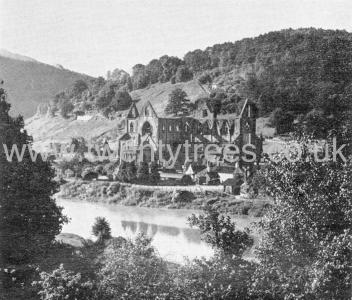
Tintern Abbey: History. 1536The coming of the Tudors to the throne, and the establishment of a strong monarchy, might have been expected to have opened an age of peace and prosperity for Tintern. But this was not to be. To Thomas Cromwell (age 51), casting round to raise funds for his master Henry VIII, the wealth of the religious houses appeared as a great prize. The monasteries were not in a strong position to withstand attack. The monastic ideal had lost its original appeal. Standards were low, and the life of the monks had become increasingly secular. The closure of the alien priories during the French wars, and, more recently, the suppression of many religious houses (notably 21 by Wolsey) on the grounds of misconduct, and the conversion of their funds to endow new schools and colleges, provided a ready precedent. In 1535 there was a general visitation of the monasteries, and in the following year an act was passed suppressing all those with revenues below £200 a year. This comprised about two-thirds of the total number of religious houses, and amongst them was Tintern Abbey [Map], which had an income of £192. In 1537 the site was granted to Henry, Earl of Worcester (age 40), whose father had married the Herbert heiress, and who was consequently the abbey’s patron at the time of its suppression.


 1792. Joseph Mallord William Turner (age 16). Tintern Abbey [Map]
1792. Joseph Mallord William Turner (age 16). Tintern Abbey [Map]
 Before 1845. Samuel Colman (age 64). "Sketching the Ruins of Tintern Abbey [Map]".
Before 1845. Samuel Colman (age 64). "Sketching the Ruins of Tintern Abbey [Map]".
Tintern Abbey: History. In 1901 the site [Tintern Abbey [Map]] was bought by the Crown from the Duke of Beaufort (age 53), the descendant of Henry, Earl of Worcester, and in 1914 its administration was transferred to the Office of Works, now Ministry of Public Building and Works. Since then the piers of the south nave arcade have been saved from collapse, the ruins consolidated, and the site gradually cleared of encroachments.
Tintern Abbey by O E Craster. 1956Tintern Abbey [Map], Monmouthshire by O. E. CRASTER, TD, MA, FSA Inspector of Ancient Monuments. London: Her Majesty’S Stationery Office. 1956.

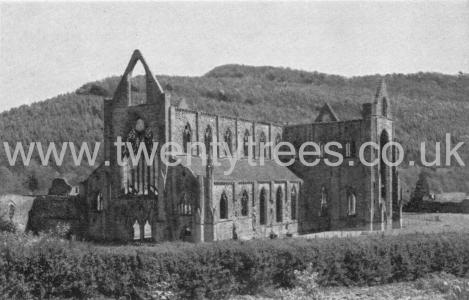
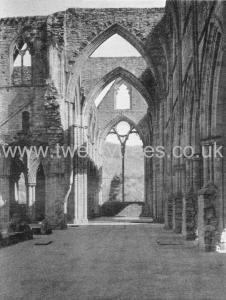
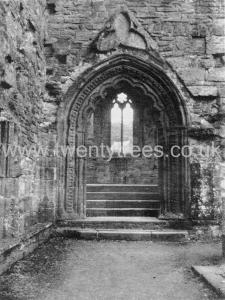
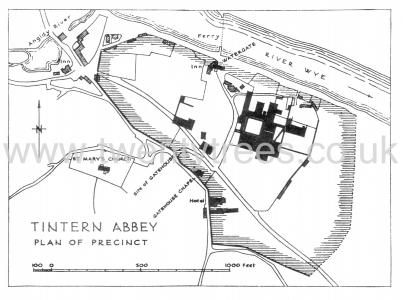
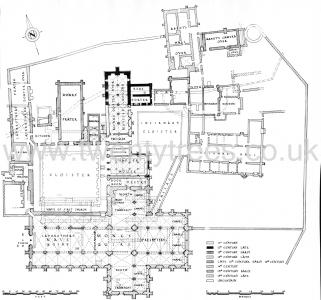
The River Wye rises on Plynlimon [Map] after which it travels through, under, or near, Rhayader [Map], Newbridge-on-Wye [Map], Builth Wells [Map], Llanstephan Suspension Bridge [Map], Glasbury-on-Wye [Map], Hay-on-Wye [Map], Clifford Castle, Herefordshire [Map], Bredwardine, Byford, Herefordshire [Map], Wye Bridge Hereford [Map], Holme Lacy, Herefordshire [Map], Capler Camp, Herefordshire [Map], through Ross-on-Wye, Herefordshire [Map], past Goodrich Castle, Gloucestershire [Map], Monmouth, Monmouthshire [Map], Tintern Abbey [Map] and Chepstow Castle [Map] joining the Severn Estuary 800m south-east of Thornwell, Monmouthshire [Map].